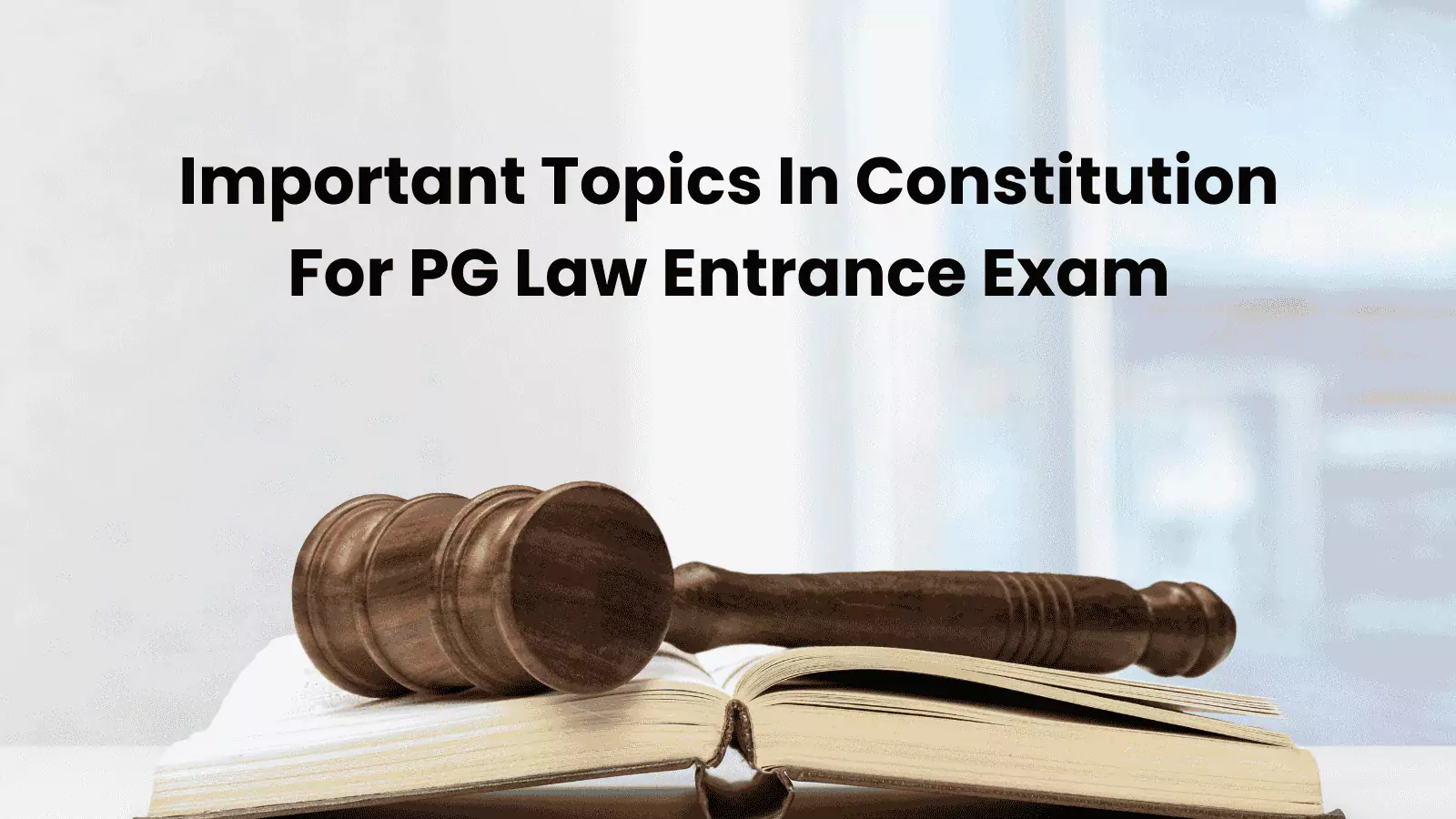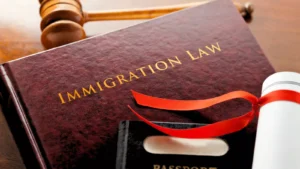Constitutional Law is the heart of every law entrance exam, shaping future lawyers, judges, and legal scholars. Mastering important topics of Constitution for judiciary helps in judiciary exam preparation as well as the bar examination.
It opens top legal careers for you. In this blog, we will cover key topics, case laws, and smart strategies to ace Constitutional Law in any law entrance exam.
Understanding the Structure of the Indian Constitution
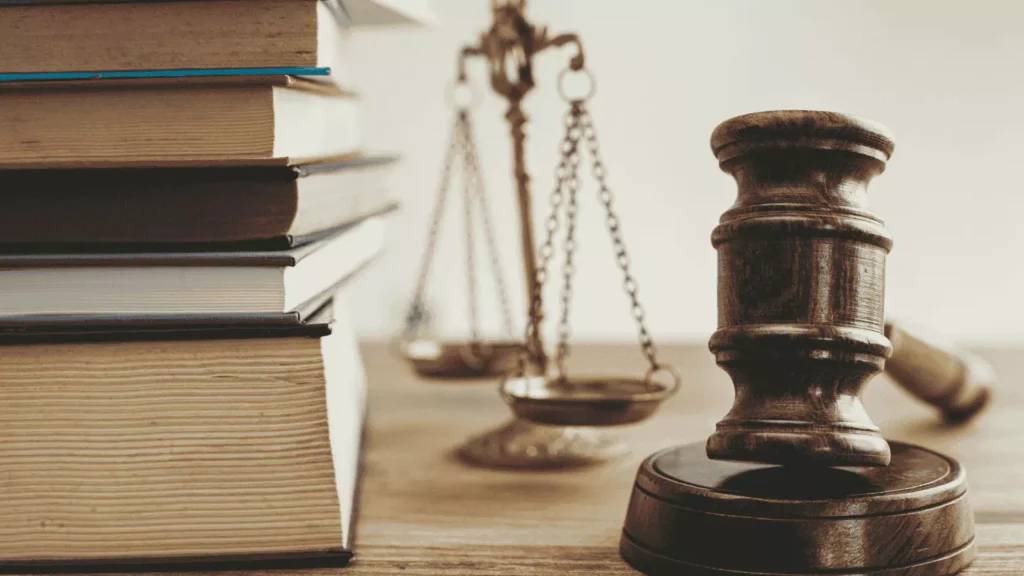
Preamble and Its Significance
The Preamble introduces the Constitutional Law and reflects India’s ideals: Justice, Liberty, Equality, and Fraternity. Courts use it to interpret laws. For example, in Keshavananda Bharati Case (1973), the Supreme Court ruled that the Preamble is part of the Constitution.
You can use the acronym ‘JELF’ to remember the four core principles of the Preamble: Justice, Equality, Liberty, Fraternity.
Fundamental Rights (Articles 12-35)
Fundamental Rights protect citizens from government overreach. Landmark cases like Maneka Gandhi v. Union of India (1978) expanded personal liberty. These rights are vital for the law entrance exam and judiciary exam preparation as they often appear in questions.
You can use the acronym ‘FRAMES’ to remember the key categories of Fundamental Rights, which are:
F – Freedom (Articles 19-22)
- Right to speech, expression, movement, profession, and assembly (Article 19).
- Protection from arbitrary arrest and detention (Article 22).
R – Rights Against Exploitation (Articles 23-24)
- No human trafficking or forced labour (Article 23).
- No child labour in hazardous industries (Article 24).
A – Articles (12-35)
- Fundamental Rights fall under Articles 12-35 of Constitutional Law.
- These rights are enforceable by courts under Article 32.
M – Minority Rights (Articles 29-30)
- Right to conserve culture, language, and script (Article 29).
- Right to establish and manage educational institutions (Article 30).
.
E – Equality (Articles 14-18)
- Right to equality before law and equal protection (Article 14).
- Abolition of untouchability (Article 17).
S – Secularism (Articles 25-28)
- Freedom of religion and practice (Article 25).
- No religious instruction in state-funded institutions (Article 28).
It will you with quick recall and a better understanding of Fundamental Rights for exams and legal discussions.
DPSP vs. Fundamental Rights
DPSPs (Articles 36-51) guide state policies, while Fundamental Rights (Articles 12-35) are legally enforceable. In Minerva Mills Case (1980), the Court ruled that both must be balanced. This is a crucial part of the bar examination and one of the most important topics of Constitution for judiciary.
You can learn the formula ‘DPSP’ to remember that Directive Principles of State Policy (DPSP) are Directive, Progressive, and Policy-based. Further, you should remember:
- D – Directive means means DPSPs are non-enforceable guidelines that direct the government to frame laws for social and economic justice. They are given in Articles 36-51 of Constitutional Law.
- P – Progressive means DPSPs focus on progressive reforms like equal pay, free education, and rural development.
- P – Policy-based means these principles guide government policies towards welfare, economic equality, and social justice. They are further divided into:
- Socialistic (e.g., Article 39 – equal wealth distribution),
- Gandhian (e.g., Article 40 – Panchayati Raj), and
- Liberal-Intellectual (e.g., Article 50 – Separation of Judiciary & Executive).
Fundamental Duties (Article 51A)
Fundamental Duties remind us of our responsibilities towards the nation. Though not enforceable, courts often refer to them. For example, in AIIMS Students Union v. AIIMS (2001), the Supreme Court linked duties with rights. These are key for judiciary exam preparation.
You can use the acronym ‘R3NPE’ to remember the Fundamental Duties under Article 51A of the Indian Constitution easily. This can be elaborated as:
R3 – Respect (Three Key Aspects)
- Respect the Constitution and uphold its ideals.
- Respect the National Flag and National Anthem (e.g., standing during the anthem).
- Respect the unity and sovereignty of India by protecting national integrity.
N – National Symbols
- Honour and preserve India’s rich cultural heritage (e.g., ancient monuments, traditions, and arts).
P – Preserve Heritage
- Protect historical sites, monuments, and culture for future generations.
E – Environment
- Safeguard forests, rivers, and wildlife.
- Develop scientific thinking and environmental awareness.
Centre-State Relations and Distribution of Powers
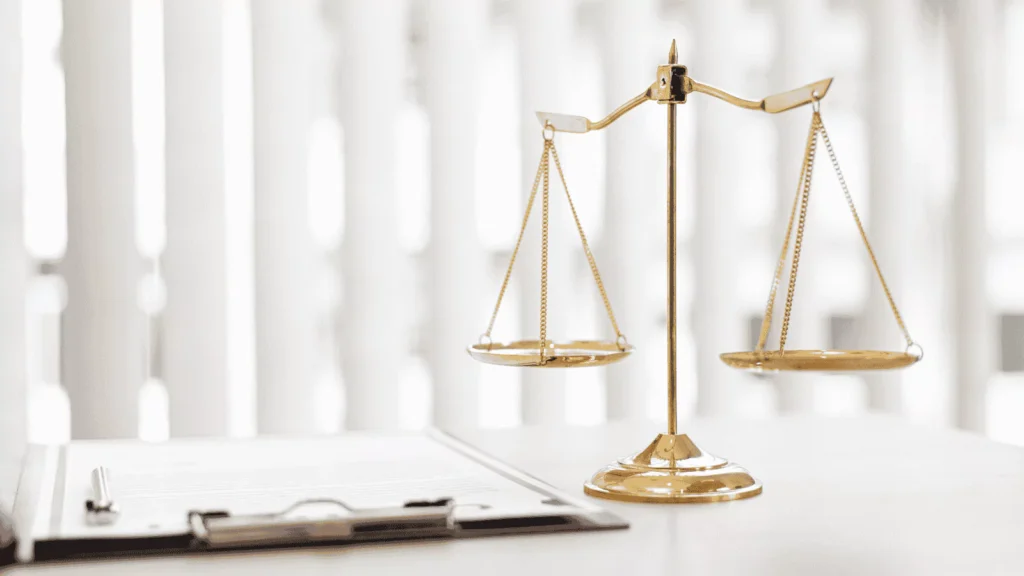
Understanding Centre-State relations is crucial for the law entrance exam, as it forms the backbone of Constitutional Law in India. The Constitution distributes powers between the Union and the States to ensure smooth governance and prevent conflicts.
Union, State, and Concurrent Lists
The Constitution divides subjects into three lists (Seventh Schedule):
- Union List (97 subjects) – Only Parliament can make laws. Includes defence, foreign affairs, atomic energy, railways, etc.
- State List (66 subjects) – States have the authority. Includes police, public health, agriculture, local government, etc.
- Concurrent List (47 subjects) – Both Parliament and State legislatures can legislate. Includes criminal law, education, marriage, trade unions, etc. If a conflict arises, the Union law prevails.
Key Landmark Judgments:
- State of West Bengal v. Union of India (1963) – Confirmed Parliament’s power over State subjects in national interest.
- SR Bommai v. Union of India (1994) – Stopped misuse of President’s Rule in States.
Doctrine of Separation of Powers in India
Unlike the rigid separation in the USA, India follows a flexible approach:
- Legislative (Parliament & State Assemblies) – Makes laws.
- Executive (President, PM, Governors, CM, Bureaucracy) – Implements laws.
- Judiciary (Supreme Court & High Courts) – Interprets laws.
The three branches have separate powers, but they interact. Courts can review laws (judicial review), but they do not interfere in policy-making.
Emergency Provisions (Articles 352-360)
During crises, the Centre gets more power under these provisions:
- National Emergency (Article 352) – Declared during war or rebellion. Parliament controls all State subjects. Fundamental Rights under Article 19 get suspended. (Example: 1975 Emergency under Indira Gandhi).
- State Emergency (President’s Rule) (Article 356) – Declared when a State fails to function properly. The Governor runs the State under the President’s direction. (Example: Karnataka (2019), Maharashtra (2019)).
- Financial Emergency (Article 360) – Declared when India’s financial stability is threatened. Salaries of government employees, including judges, can be reduced. (Never used in India so far).
For judiciary exam preparation and the bar examination, understanding Centre-State relations helps in answering questions about power distribution. Important topics of Constitution for judiciary include the Lists, landmark cases, and Emergency provisions. Remember, Parliament has more power, but States play a key role in governance.
Constitutional Amendments and Landmark Cases
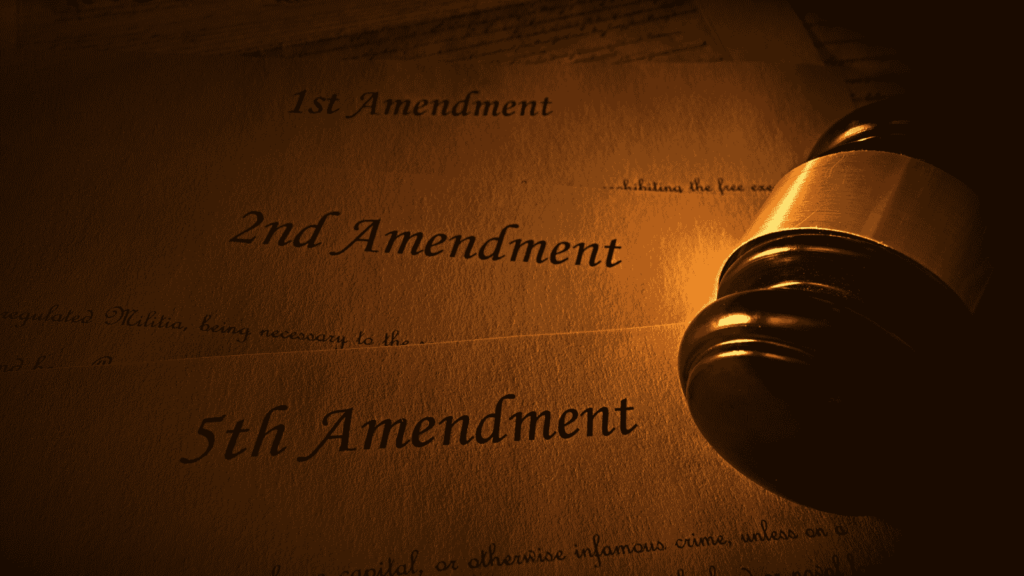
Understanding how India’s Constitution changes over time is important for anyone preparing for the law entrance exam, judiciary exam preparation, or the bar examination. Here’s what you need to remember:
How is the Constitution Amended? (Article 368)
The Indian Constitution is not rigid like the US Constitution, nor is it completely flexible like the British Constitution. Article 368 provides three ways to amend it:
- Simple Majority – Some amendments, like changes in Parliament rules, require just more than 50% votes in both Houses.
- Special Majority – Most amendments need at least two-thirds votes in both Houses of Parliament.
- Special Majority + State Approval – Amendments affecting federal structure (e.g., election of the President, powers of the Supreme Court) require approval from at least half of the states.
Key point to remember: The President cannot refuse to sign an amendment once Parliament passes it.
Doctrine of Basic Structure – Landmark Cases
The Basic Structure Doctrine ensures that Parliament cannot destroy the core values of the Constitution, even with amendments.
Key Cases:
- Kesavananda Bharati v. State of Kerala (1973) – The Supreme Court ruled that Parliament can amend the Constitution, but it cannot change its basic structure (e.g., democracy, secularism, fundamental rights).
- Minerva Mills v. Union of India (1980) – Strengthened the basic structure doctrine, ruling that Fundamental Rights cannot be destroyed to give unlimited power to the government.
- I.R. Coelho v. State of Tamil Nadu (2007) – Any law violating the basic structure can be struck down, even if placed under the Ninth Schedule (which usually protects laws from judicial review).
Important Constitutional Amendments and Their Impact
Many amendments have reshaped India’s political and legal system. You must remember:
- First Amendment (1951) – Allowed the government to impose reasonable restrictions on free speech (e.g., national security, public order).
- Seventh Amendment (1956) – Reorganised Indian states based on language.
- Twenty-Fourth Amendment (1971) – Gave Parliament full power to amend the Constitution, countering the Golaknath case (1967), which had limited this power.
- Forty-Second Amendment (1976) – “Mini-Constitution” – Added words “Socialist” and “Secular” to the Preamble and gave Parliament more power.
- Forty-Fourth Amendment (1978) – Restored Fundamental Rights removed during Emergency (1975).
- Seventy-Third & Seventy-Fourth Amendments (1992) – Introduced Panchayati Raj and Municipalities, giving local bodies constitutional status.
- Ninety-Third Amendment (2005) – Introduced OBC reservations in educational institutions.
- One Hundred and First Amendment (2016) – Introduced GST (Goods and Services Tax).
Powers and Functions of the Executive, Legislature, and Judiciary
The executive, legislature, and judiciary function together but have separate powers under Constitutional Law. Let us discuss them in detail.
Role of the President and Governor
The President (Union Executive) and Governor (State Executive) have similar roles, but the President is for the country, and the Governor is for a state.
Powers
- Executive Powers – Appoints the Prime Minister (PM) and Chief Ministers (CMs), Ministers, Supreme Court (SC) and High Court (HC) judges.
- Legislative Powers – Summons, prorogues Parliament or State Assemblies; gives assent to bills.
- Financial Powers – Presents the Budget, Money Bills need their approval.
- Judicial Powers – Can grant pardons, reprieves, and commute sentences.
- Emergency Powers – Can declare a National Emergency (Article 352), President’s Rule in a state (Article 356), and Financial Emergency (Article 360).
Impeachment
🔹 President can be removed through impeachment (Article 61) for violating the Constitution.
🔹 Governor can be appointed and removed by the President at will (No fixed term).
Discretionary Powers
- President can return a bill (except a Money Bill) once for reconsideration.
- Governor can reserve bills for the President’s assent, dissolve the Assembly in certain cases, and recommend the President’s Rule.
Independence of the Judiciary
The judiciary is independent to ensure justice without political pressure. Here are some key details to remember:
Appointment of Judges
- Supreme Court (SC) Judges are appointed by the President after consulting senior judges (Collegium System).
- High Court (HC) Judges are appointed by the President after consulting the Chief Justice of India (CJI), Governor, and HC Chief Justice.
Removal of Judges
- SC & HC Judges can be removed only by impeachment (proved misbehaviour/incapacity) by Parliament (Article 124(4)).
- No judge has been impeached yet.
Powers of Judiciary
- Judicial Review – Can check the constitutional validity of laws.
- Writ Jurisdiction – Can issue writs to protect Fundamental Rights (Article 32 for SC, Article 226 for HC).
- Advisory Jurisdiction – The President can seek SC’s advice (Article 143).
Judicial Review and Judicial Activism
Judicial Review means SC and HC can strike down unconstitutional laws.
Judicial Activism means courts take proactive steps to protect rights. It uses Public Interest Litigation (PIL) to ensure justice.
Understanding these concepts is essential for judiciary exam preparation and tackling important topics of Constitution for judiciary in the bar examination.
Important Constitutional Doctrines for Judiciary Exam Preparation
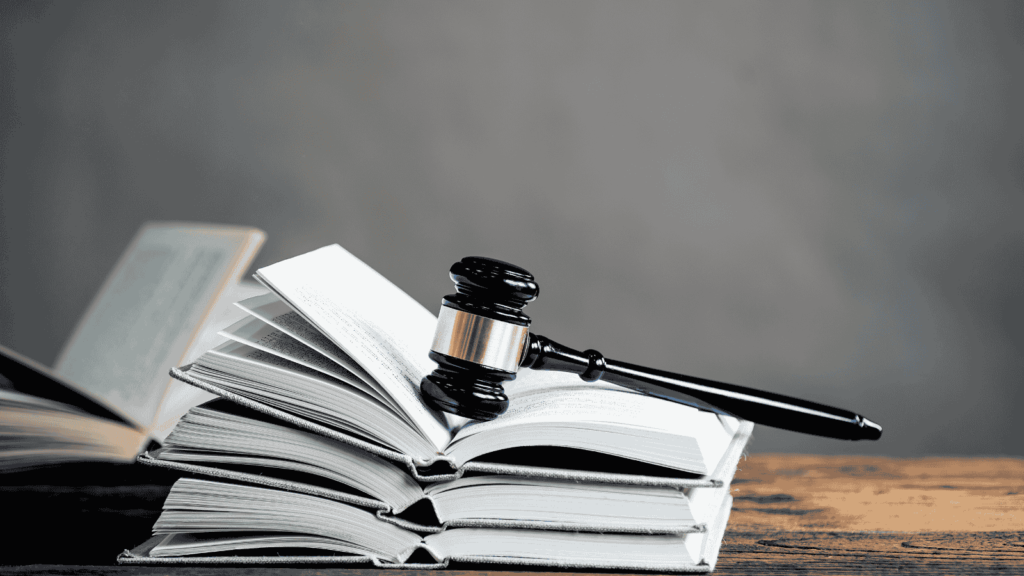
Key doctrines in Constitutional Law help courts interpret laws and resolve conflicts. Here are five important topics of Constitution for judiciary aspirants:
1. Doctrine of Basic Structure
This doctrine states that Parliament can amend the Constitution but cannot change its basic structure.
2. Doctrine of Eclipse
If a law violates fundamental rights, it becomes inactive, not void. It revives when the conflict is removed. This applies only to pre-constitutional laws.
3. Doctrine of Pith and Substance
Used to resolve legislative conflicts between Centre and State laws, this doctrine states that if a law’s true purpose (pith) matches the assigned subject list, it remains valid, even if it slightly overlaps another list.
4. Doctrine of Colourable Legislation
When a legislature pretends to make a law under its power but actually encroaches on another’s power, the law is invalid.
5. Doctrine of Harmonious Construction
When two laws or constitutional provisions conflict, courts interpret them to make both work together instead of invalidating one.
These doctrines are key for judiciary exam preparation and essential in answering important topics of Constitution for judiciary.
Fundamental Rights and Their Limitations
Fundamental Rights are guaranteed under Part III of the Constitution. However, these rights are not absolute and come with reasonable restrictions. Here are some things to remember:
Right to Equality (Articles 14-18) and Case Laws
- Article 14 – Equal protection of laws.
- Article 15 – No discrimination based on religion, race, caste, sex, or place of birth.
- Article 16 – Equal opportunity in public employment.
- Article 17 – Abolition of untouchability.
- Article 18 – No titles except military/academic.
Reservations and special provisions for weaker sections are exceptions.
Right to Freedom (Articles 19-22) – Reasonable Restrictions
- Article 19 mentions six freedoms (speech, movement, association, etc.). It has some restrictions, such as security of the state, public order, morality, etc.
- Article 20 mentions no ex-post-facto laws, no double jeopardy, and right against self-incrimination.
- Article 21 mentions the right to life & personal liberty.
- Article 22 mentions protection from arbitrary arrest and the rights of detainees.
Preventive detention is allowed for national security.
Right against Exploitation (Articles 23-24)
- Article 23 mentions that there can be no human trafficking and forced labour.
- Article 24 mentions that there should be no child labour in hazardous jobs.
Compulsory service for public purposes is allowed though.
Right to Freedom of Religion (Articles 25-28)
- Article 25 mentions the freedom to practice any religion.
- Article 26 mentions the right to manage religious affairs.
- Article 27 mentions that there can be no tax for promoting any religion.
- Article 28 mentions that no religious instruction should be given in government schools.
There’s a limitation to religious freedom. It does not override public order, morality, or health.
Right to Constitutional Remedies (Article 32) – Writ Jurisdiction
- Article 32 allows people to approach the Supreme Court for rights enforcement.
- Some of the important writs to remember are:
- Habeas Corpus for release of illegal detention.
- Mandamus to order public officials to perform duties.
- Prohibition to stop a lower court from exceeding jurisdiction.
- Certiorari to quash unlawful orders of a lower court.
- Quo Warranto to question the legality of a public office.
However, during Emergency (Article 359), Article 32 can be suspended.
Role of the Supreme Court and High Courts
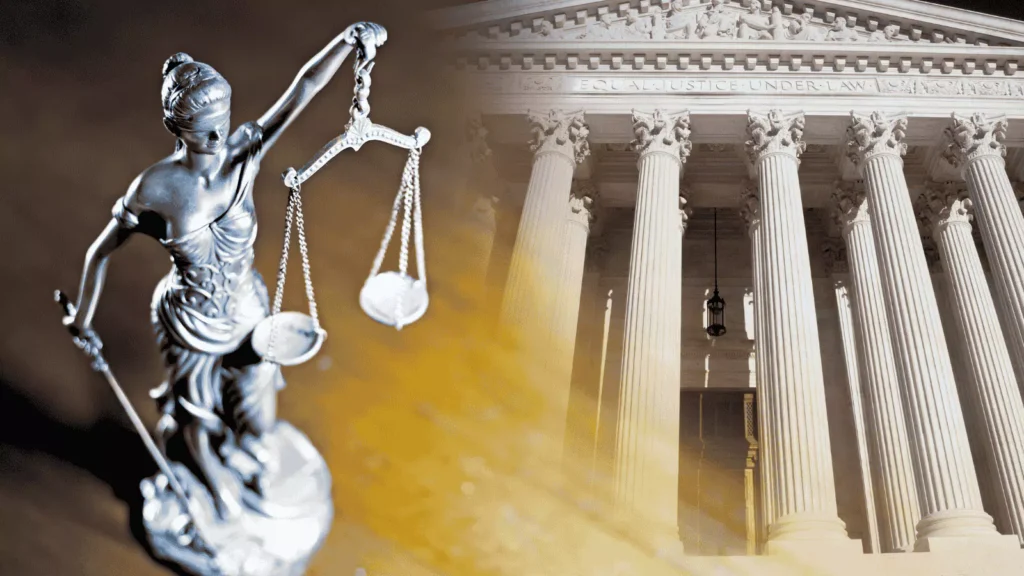
The Supreme Court and High Courts play a key role in upholding justice, protecting fundamental rights, and interpreting the Constitutional Law. Their powers include writ jurisdiction, Public Interest Litigation (PIL), and Special Leave Petitions (SLP).
Writ Jurisdiction under Articles 32 and 226
Article 32 gives the Supreme Court the power to issue writs for the protection of Fundamental Rights. Article 226 allows High Courts to issue writs for both Fundamental Rights and other legal rights. This makes High Courts more flexible than the Supreme Court.
Public Interest Litigation (PIL) and Its Significance
PIL allows anyone to approach courts for issues affecting the public at large. The Supreme Court and High Courts entertain PILs under Articles 32 and 226. It ensures justice for the poor, oppressed, and those without legal resources.
Special Leave Petition (SLP)
SLP (Article 136) allows the Supreme Court to hear appeals against any judgment from any court or tribunal in India. It gives wide discretionary power but is not an automatic right.
SLP helps in constitutional interpretation, setting legal precedents, and protecting rights. However, the Supreme Court rejects many SLPs if they do not involve serious legal questions.
Conclusion
Mastering Constitutional Law is essential for every law entrance exam and judiciary exam preparation. By understanding the important topics of Constitution for judiciary, key cases, and doctrines, you gain a strong legal foundation.
Stay consistent, revise regularly, and apply these insights to ace the bar examination and secure a top legal career!
Read Also – Best AILET PG Law Preparation Tips For You
The Rise of Single-Use Plastic Bans on Campuses:A Sustainable Shift Towards Eco-Friendly Futures

